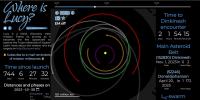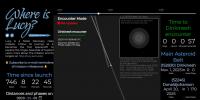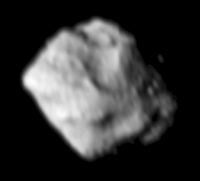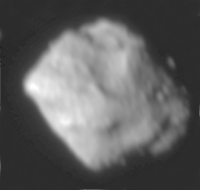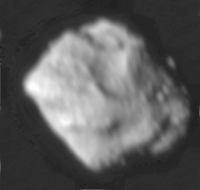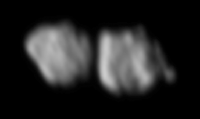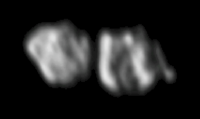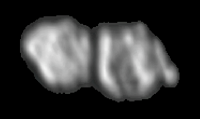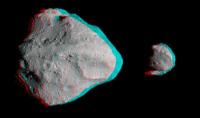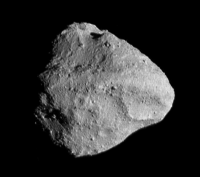Printable Version of Topic
Click here to view this topic in its original format
Unmanned Spaceflight.com _ Cometary and Asteroid Missions _ Lucy
Posted by: PhilipTerryGraham Jan 4 2017, 08:20 PM
Obligatory new thread for the Lucy mission, now that it has been https://www.nasa.gov/press-release/nasa-selects-two-missions-to-explore-the-early-solar-system/ Lucy will launch in 2021, and will perform a flyby of a main belt asteroid in 2025, before making flybys of at least six Jupiter trojans from 2027 to 2033. The mission, led by the Southwest Research Institute and Principal Investigator Harold F. Levison, will send a spacecraft carrying updated versions of New Horizons' LORRI and RALPH instruments.
Be sure to check out https://www.reddit.com/r/lucymission on reddit as well!
EDIT: I have made a mistake. Could a kind mod please move this thread to the "Cometary and Asteroid Missions" subforum? ![]()
ADMIN: Done.
Note for the new members: Generally speaking, please consult a member of the admin/mod team before creating new topics. Not a hard rule, but it does help to keep the place tidy. Also, we encourage all members to review this http://www.unmannedspaceflight.com/index.php?showtopic=7184&pid=181915&st=0&#entry181915 for orientation purposes. Thanks! ![]()
Posted by: Patteroast Jan 10 2017, 10:56 AM
Very excited for this mission. I'm a sucker for seeing new worlds, and I didn't realize Patroclus-Menoetius was a target for Lucy until it was selected. And so many others, too! ![]()
Posted by: Mongo Apr 6 2019, 05:56 PM
This https://arxiv.org/abs/1902.04591 on arXiv suggests that Jupiter formed past Neptune and then migrated inwards to its current orbit, sweeping up the Jupiter Trojan asteroids with it. They make a compelling case, that explains the otherwise inexplicable asymmetry between the leading and trailing Trojan clouds.
This would mean that there is an incredible compositional diversity within the Trojans, due to their origins ranging from the inner Kuiper belt to the location of the current Hilda asteroids. So the Lucy mission has the opportunity to visit bodies originating throughout the middle and outer solar system, which makes it even more important for understanding the history of the solar system.
Posted by: Holder of the Two Leashes Oct 24 2019, 01:07 PM
They are ready to start building the spacecraft.
http://lucy.swri.edu//2019/10/21/CDR.html
Posted by: Explorer1 Jan 10 2020, 12:50 AM
Cool news a satellite discovered around one of the flyby targets!
https://www.nasa.gov/feature/nasa-s-lucy-mission-confirms-discovery-of-eurybates-satellite
Posted by: stevesliva Aug 17 2021, 04:56 PM
Turns out Lucy might get pretty darn close to said Satellite:
https://twitter.com/plutokiller/status/1401894522859122694
(Tweets from June)
Lucy scheduled for Launch in October.
Posted by: mcaplinger Sep 20 2021, 12:30 AM
Some open-access papers about the Lucy mission here: https://iopscience.iop.org/issue/2632-3338/2/5
Posted by: propguy Oct 14 2021, 10:00 PM
Lucy launch is only 2 days away. We are now powered for the last time and this AM moved to the pad at LC41 and looking at a nice early AM launch on 10/16 (0934 UTC, 0534 EDT) with great weather forecasat. Hope everyone is going to get up early with us for launch. There was a very good pre-launch press briefing yesterday that is on YouTube (sorry for all the commercials I could not find any alternate hosting sites,https://www.youtube.com/watch?v=EzowYD-ZVxg). Hope you have a chance to watch the launch live (or after getting up for those in the US). I have seen some questions on forums such as reddit asking what propulsion elements Lucy has (All of the following info is not export controlled so I can provide these answers here). We have eight 1 N and six 22 N mono-propellant thrusters for ACS and the majority of the trajectory correction maneuvers (up to 50 m/sec). For larger burns we have a 470 N bi-propellant main engine (Leros 1C). The propellants are hydrazine and dinitrogen tetroxide. There are currently 4 burns over 7 years that will use our main engine. We won't need to use that engine till mid 2024 (large DSM to target Earth for an Earth flyby). Go Lucy!!!
Posted by: john_s Oct 15 2021, 01:56 AM
Some of us here are on the science team too- happy to (attempt to) answer any science questions.
At the Cape, trying to type with fingers crossed!
John
Posted by: Explorer1 Oct 15 2021, 02:36 AM
Sure, we really appreciate it, having representatives from both side of the mission coin on here!
Having watched the briefing from earlier; will the geometry of the Earth flybys allow for some great (colourful) views for L'LORRI (or even during commissioning)? LORRI on New Horizons never looked back at Earth even to this day....
Posted by: john_s Oct 15 2021, 02:50 AM
Imaging the Earth will likely be done for calibration, but we might have saturation issues, so don’t yet know how pretty the pictures will be. The moon will also likely be a calibration target and less likely to saturate. The geometry will depend on our launch date, so we’ll know soon!
John
Posted by: Ron Hobbs Oct 15 2021, 03:22 AM
Watched the Science Press Conference today. Excited to follow this mission.
GO LUCY!!!
Posted by: Holder of the Two Leashes Oct 15 2021, 04:11 PM
Hmmm. Since this Atlas launch will be without any SRBs, a couple of shock diamonds might be just barely visible in the far end of the exhaust of the rocket.
If so, I can think of a caption for that photo ...
Posted by: nprev Oct 16 2021, 06:04 AM
Hoping to keep my eyes open long enough to watch the launch tonight.
GO LUCY!!!
Posted by: Explorer1 Oct 16 2021, 01:47 PM
Go up early to watch the launch! Beautiful! All the best to the team, and looking forward to the first images!
1 year to Earth flyby....
Posted by: Floyd Oct 16 2021, 04:49 PM
I also watched the launch this morning--it is always breathtaking. I understand the huge solar panels unfolded properly.
Posted by: Tom Tamlyn Oct 17 2021, 01:59 AM
The best general media article I’ve run across concerning the Lucy Mission is this one in the New York Times. (I assume it’s paywalled, although the NYT is a little more generous with free articles than it was.)
https://www.nytimes.com/article/nasa-lucy-trojans-asteroids.html
The article is nicely written, features some particularly good graphics, and most importantly, feels more comprehensive than is typical for the twenty-first century NYT science section.
This was a mild surprise. I’m a life-long reader and admirer of the New York Times science desk. However, since the MER rover missions renewed and intensified my interest in planetary science in 2004, I’ve frequently felt that the NYT’s fine writers were not allowed enough ink to do do justice to planetary missions. I began to rely much more on specialist journals and online sources, especially Emily Lakdawalla, and particularly during her time at the Planetary Society, and of course this forum.
The article's author, David W. Brown, is a freelancer who has apparently just published a book on the Europa Clipper mission with the following title:
I'm not a fan of goofy long book titles that don't include useful search terms in the first few words, or in this case, anywhere at all, but on the strength of Brown's article about Lucy, I'm going to read his book.
Posted by: Explorer1 Oct 17 2021, 02:59 AM
I posted a minor review of the audiobook in the Europa Clipper thread: http://www.unmannedspaceflight.com/index.php?s=&showtopic=8404&view=findpost&p=251818
He's a good writer, though naturally he can only write about non-confidential subject matter, so he is limited to some degree.
Posted by: stevesliva Oct 17 2021, 03:08 AM
Re: NYT: this reads like a Science Tuesday section front page, and that's where I'd expect to see it in print.
Posted by: JTN Oct 17 2021, 09:54 AM
I think https://twitter.com/derekiswise/status/1449337859484356612 (https://pbs.twimg.com/media/FB0VCQ-XoAAcG23.jpg:orig) might show such.
Also, the https://spaceflightnow.com/2021/10/16/nasa-asteroid-explorer-leaves-planet-earth-on-atlas-5-rocket/ article has "A tiny diamond buried deep inside the L’TES spectrometer acts as a beam splitter".
Posted by: Decepticon Oct 18 2021, 03:39 AM
https://spacenews.com/nasa-investigating-issue-with-lucy-solar-array/
Posted by: Explorer1 Oct 19 2021, 02:23 PM
They're optimistic that it's not a major issue: RCS thrusters worked already, main change has been a delay in deploying the instrument platform:
https://spaceflightnow.com/2021/10/18/nasa-officials-optimistic-lucy-asteroid-mission-will-overcome-solar-array-snag/
EDIT: More details, directly from the team:
https://blogs.nasa.gov/lucy/2021/10/19/nasa-team-remains-focused-on-lucys-solar-arrays/
Posted by: Hungry4info Oct 24 2021, 07:49 PM
Lucy update. We're now in cruise mode, with the instrument platform deployed. They're going to turn the spacecraft to various attitudes to try to use the current measurement from the stuck array to determine how far it deployed to better inform how to fix it. https://scitechdaily.com/nasa-issues-update-on-lucy-spacecraft-and-its-solar-array-problem/amp/
Posted by: Explorer1 Oct 29 2021, 01:44 AM
https://blogs.nasa.gov/lucy/2021/10/27/lucy-stable-in-cruise-mode/
Next attempt to fully deploy no earlier than November 16th. Instrument checkout going on as planned, some minor manouvers have been completed.
Array is 75 - 95 % deployed, team estimates.
Posted by: lcs Oct 30 2021, 12:53 PM
Something similar happened on Galileo. Possible explanation?
https://www.mdpi.com/2075-4442/9/8/72?type=check_update&version=2
Posted by: stevesliva Oct 30 2021, 02:26 PM
The mechanisms are different, and Galileo was in storage for too many years.
The status report above mentions a 'lanyard'. There is a timelapse video from a deployment test here: https://www.youtube.com/watch?v=6vjK9vGEw5Q
My guess is that the lanyard they mention is seen here. It starts pulling around the fulcrum at the center of the array, and then pulls across the screen, and then is off screen.
Posted by: Explorer1 Oct 30 2021, 02:29 PM
Lucy was never in storage for an extended period due to delays. I'm sure they're thinking over every possibility. Although we all hope the array finishes deploying, I have been thinking that if this isn't fixed by the time of the Earth flyby next year, the low altitude combined with the size of the arrays, might make it possible to resolve the stuck array directly with Earth-based imagery?
Posted by: mcaplinger Oct 30 2021, 05:31 PM
See https://www.jpl.nasa.gov/nmp/st8/tech_papers/2005%20IEEE%20Aerospace%20Conference%20_Big%20Sky_%20Paper-%20NGU%20ST8.pdf for some information about how Ultraflex arrays work (BTW, ST8 never flew as far as I know). I don't know what kinds of position information or other telemetry (e.g., motor current) they get during deployment. What's been said suggests that all they get is a single binary flag showing full latching, but I doubt that's true.
It's not at all obvious to me if images, especially ground-based, would be of any use whatsoever to fixing the problem. The TTCAM cameras could in theory produce out-of-focus images of the spacecraft, but I don't know if their placement and platform articulation would allow anything useful of the panel (links to a paper on those cameras upthread.)
There's a lengthy, mostly off-topic discussion of this at https://forum.nasaspaceflight.com/index.php?topic=46685.0 if you're into that kind of thing.
Posted by: JRehling Oct 31 2021, 02:30 AM
An object 300 km from a telescope on the ground might enable imagery with resolution as good as about 10 cm per pixel… but that assumes a lot, including good weather at the sub-spacecraft point, which is completely beyond anyone's control or ability to predict, as well as two geometric factors that are knowable in advance, but not known to me: Will the spacecraft be near closest approach over land vs. the 70% of Earth that is water, and will the spacecraft be in sunlight at the time of closest approach, but not lost in daylight? This all sounds well below 50% probability, but not impossible.
Posted by: mcaplinger Oct 31 2021, 03:00 AM
Color me skeptical that this is 1) possible or 2) useful, but feel free to check out the geometry -- the best trajectory info so far is https://naif.jpl.nasa.gov/pub/naif/LUCY/kernels/spk/lcy_211016_330403_211021_od003-R-TCM3-P-TCM36-P_v2.bsp
Posted by: Floyd Oct 31 2021, 03:35 PM
With the low cost and weight of small cameras, I'm surprised there were not two cameras dedicated to viewing the solar arrays and documenting their deployment.
Posted by: mcaplinger Oct 31 2021, 05:17 PM
The overall system cost is probably not as low as you think, and it's not at all clear that documenting the deployment would help you fix a problem. Without knowing the details of the system it's impossible to know. There's more than enough poorly-informed discussion of this at the link I provided above.
If you want small space-rated cameras we would be happy to sell you some, and in fact there are two on Lucy: https://www.msss.com/news/index.php?id=131
Posted by: JRehling Oct 31 2021, 09:10 PM
I don't have the software to turn that kernel data into the flyby specifics, but I'll emphasize that it seems unlikely that a best-case scenario for ground imaging would occur.
If it did, I still maintain that decimeter-scale resolution is possible, at least if we were trying to determine the degree that the solar array had deployed, from a continuum of known possibilities. Measuring the separation between two linear features measuring many pixels long allows for much greater accuracy than trying to image an unknown object. It would be quite similar to the situation where Vernier acuity is measured. As the Wikipedia article (accurately) states, "vernier acuity exceeds acuity by far."
https://en.wikipedia.org/wiki/Vernier_acuity
Here is an image of the ISS that approaches the best case resolution. As a comparison, this telescope has something like 3x the aperture of HiRise, which images subjects 300 km away.
https://m.facebook.com/MilroyCoonabarabran/photos/a.1354554487994275/3082271308555909/?type=3
But, again, there's no reason other than hope that a single opportunity would achieve results like the best of virtually unlimited opportunities to image the ISS. I don't predict a productive outcome for such an effort.
Posted by: bobik Nov 8 2021, 07:14 AM
Is that so? The BepiColombo project https://theconversation.com/bepicolombos-first-close-up-pictures-of-mercurys-surface-hint-at-answers-to-the-planets-secrets-168159 to a completely integrated spacecraft less than two years before launch, and ESA - especially ESA's Science Programme isn't known for swimming in money. Yes, however, https://blogs.nasa.gov/lucy/2021/10/27/lucy-stable-in-cruise-mode/ of the deployment state doesn't help to fix or assess the problem either.
Posted by: mcaplinger Nov 8 2021, 06:14 PM
Unless you can produce an actual cost figure then this is at best circumstantial. I have a pretty good idea of how much it would have cost on Lucy, but can't discuss specifics.
This is all 20-20 hindsight. What I don't know is how much telemetry of the array state they get. Obviously they weren't expecting a problem.
Posted by: Marcin600 Nov 19 2021, 12:47 AM
"...The test data and findings suggest the lanyard may not have wound on the spool as intended. Testing continues to determine what caused this outcome, and a range of scenarios are possible. The team isn’t planning to attempt to move or further characterize the current state of the solar array deployment before Wednesday, Dec. 1, at the earliest."
"...Checkouts for the Lucy instruments were successfully completed Nov. 8, and all instruments are working normally..."
https://blogs.nasa.gov/lucy/2021/11/18/lucy-instruments-checkout-a-ok/
https://twitter.com/NASASolarSystem/status/1461393961629757450
Posted by: JTN Dec 11 2021, 06:23 PM
https://blogs.nasa.gov/lucy/2021/12/08/nasa-zeroing-in-on-path-forward-for-lucy-solar-array/ (8 Dec)
Posted by: MahFL Dec 11 2021, 06:51 PM
Sounds good.
Posted by: Decepticon Jan 26 2022, 04:56 AM
Update on Solar array.
https://spacenews.com/cause-of-lucy-solar-array-deployment-problem-identified/
Posted by: john_s Apr 21 2022, 08:21 PM
We're planning the first step of the Lucy solar array re-deployment attempt on the week of May 9th- see https://blogs.nasa.gov/lucy/2022/04/21/nasas-lucy-mission-is-go-for-solar-array-deployment-attempt/ for details. Fingers crossed!
John
Posted by: john_s May 15 2022, 08:16 PM
Two Lucy items of interest:
1) The first step of the solar array redeployment test was completed last week: https://blogs.nasa.gov/lucy/2022/05/10/nasas-lucy-team-completes-step-one-of-the-solar-array-deployment-attempt/. Data analysis is under way.
2) We'll be making a movie of tonight's lunar eclipse! As far as I know, this will be the first movie of a lunar eclipse from deep space, though someone here might be able to correct me. See http://lucy.swri.edu/2022/05/12/LunarEclipse.html
John
Posted by: Explorer1 May 20 2022, 06:59 PM
And here it is! https://www.nasa.gov/feature/goddard/2022/nasas-lucy-mission-observes-a-lunar-eclipse
Posted by: StargazeInWonder May 21 2022, 04:40 AM
What a beautiful result. It might be surprising to people who've spotted a lunar eclipse and could easily see the Moon during totality that the eclipsed Moon is much darker than the full Moon, by a factor of hundreds or more. So, in a video that does not adjust the brightness to compensate, the Moon will seem simply to go black.
Posted by: john_s May 22 2022, 09:40 PM
Here's a repeating version, which I prefer to the version that was posted on NASA.
John
Posted by: JTN Jun 12 2022, 12:50 AM
Tidbits on Lucy solar array deployment:
https://blogs.nasa.gov/lucy/2022/06/08/nasas-lucy-mission-continues-solar-array-deployment-process/ (Lucy blog, June 8): not latched yet, but four attempts (May 9, May 12, May 26, June 2) all show array continuing to open and stiffen. More attempts are possible.
https://spacenews.com/efforts-continue-to-fully-deploy-lucy-solar-array/ (spacenews,com, also June 8) has quotes from Hal Levison:
That tensioning, he said, is a positive sign even though the array has not latched into place. “It makes it likely that, even if we don’t get the thing latched, we’ll be able to fly the mission as-is,” he said, noting the array, in its current configuration, is generating more than 90% of its planned power.
Posted by: Explorer1 Jun 16 2022, 04:08 PM
New moon of Polymele discovered (due to a recent occultation)!
Good summary here, including of the array issue:
https://spaceflightnow.com/2022/06/14/nasa-making-progress-deploying-stuck-solar-panel-on-lucy-asteroid-probe/
The occultation observations were intended to help the Lucy science team determine the shape of Polymele, which only appears as a point of light in telescope images.
“We got a really nice projected shape of Polymele, and then we were very surprised to detect an object about 200 kilometers (120 miles) away from Polymele,” Levison said last week in a presentation to NASA’s Small Bodies Advisory Group. “It’s 5 kilometers (3 miles) in diameter, and it’s sitting almost exactly in Polymele’s equatorial plane.”
Posted by: Explorer1 Aug 3 2022, 07:04 PM
Good news for the array:
https://www.nasa.gov/feature/goddard/2022/nasa-team-troubleshoots-asteroid-bound-lucy-across-millions-of-miles
Posted by: Steve G Aug 3 2022, 07:20 PM
Has there been any estimates released on the orbital period of the newly discovered moon? Specifically, are they mutually tidally locked to the other?
Posted by: Toma B Oct 15 2022, 08:31 AM
Does anybody know when do we get the first images from Earth's gravity assist?
This should be a great test of what those cameras can do. ![]()
Can Lucy take better image sequences than Galileo or Messenger spacecraft during this flyby?
Posted by: mcaplinger Oct 15 2022, 03:48 PM
Speculation as we have no operational role in this mission --
DSN Now shows 20 kbit/s down, most likely on the LGA/MGA due to spacecraft orientation. I doubt if we will see anything until after the flyby is complete and they can send the data back at a higher rate.
It took about 2 months before the 14 Feb 2022 star images were released ( https://www.nasa.gov/feature/goddard/2022/checking-in-on-the-cameras-of-nasa-s-asteroids-bound-lucy-spacecraft ) but hopefully some flyby images will show up more quickly.
Posted by: john_s Oct 16 2022, 04:29 AM
We'll be imaging the Earth and Moon a few times during the flyby, but no Galileo-style color movies- the science cameras are rather limited in what they can do at 1 AU, due to overexposure. We're hoping for some nice images of the Moon after Earth closest approach, however.
I'm hoping to see the spacecraft itself with binoculars on Sunday morning, from Western Nebraska where we've come to avoid clouds in Colorado. It should be much brighter from north-west Australia, just before closest approach, for anyone in that part of the world. See http://lucy.swri.edu/SpotTheSpacecraft-EGA1.html
John
Posted by: mcaplinger Oct 18 2022, 04:10 PM
Lucy downlinking now at 353 kb/sec to DSS14.
Posted by: mcaplinger Oct 25 2022, 03:39 PM
https://www.nasa.gov/image-feature/goddard/2022/nasas-lucy-spacecraft-captures-earth-moon-ahead-of-gravity-assist
I was sort of expecting science instrument images to be highlighted over T2CAM images, but I'm not complaining.
Posted by: john_s Oct 25 2022, 06:50 PM
It's just a matter of what was ready when. Science camera images will follow shortly.
John
Posted by: Bill Harris Oct 25 2022, 09:10 PM
I'm hoping to see the spacecraft itself with binoculars on Sunday morning, from Western Nebraska where we've come to avoid clouds in Colorado. It should be much brighter from north-west Australia, just before closest approach, for anyone in that part of the world. See http://lucy.swri.edu/SpotTheSpacecraft-EGA1.html
John
Still, 6th-7th mag from North America shouldn't be that impossible with binocs. Seems that the "proper motion" of the spacecraft won't be all that large.
Even if you get clouded out, there are still 2 flybys to possibly try again.
--Bill
Posted by: john_s Oct 25 2022, 09:48 PM
For the record, I didn't catch it in my binoculars, but we saw it live with an 11" telescope, which was quite thrilling. We followed it for about 30 minutes until we lost it in twilight- it got rapidly slower and dimmer during that time as it climbed away, in the general direction of the Moon.
John
Posted by: climber Oct 26 2022, 07:38 PM
Here is the Moon : https://www.nasa.gov/image-feature/goddard/2022/nasa-s-lucy-spacecraft-views-the-moon
Posted by: Hungry4info Jan 25 2023, 11:34 PM
We're getting a bonus flyby! Lucy will visit the small main belt asteroid 1999 VD57 on 01 Nov 2023.
https://www.nasa.gov/feature/goddard/2023/nasa-s-lucy-team-announces-new-asteroid-target
Posted by: Explorer1 Jan 26 2023, 09:51 PM
Combined with the new moons discovered fro the primary targets, I think they're trying to beat Cassini's record... ![]()
Posted by: john_s Apr 13 2023, 10:24 PM
Here are the first Lucy images (movies, in fact) of four of our five primary Trojan asteroid targets:
https://www.nasa.gov/image-feature/goddard/2023/nasa-s-lucy-mission-snaps-its-first-views-of-trojan-asteroid-targets
John (Lucy deputy project scientist)
Posted by: Brian Swift Apr 14 2023, 03:56 AM
https://www.nasa.gov/image-feature/goddard/2023/nasa-s-lucy-mission-snaps-its-first-views-of-trojan-asteroid-targets
And a camera-shy asteroid scooting out of frame in the upper left of 4th video.
Posted by: john_s Sep 13 2023, 02:27 PM
Here's our https://www.nasa.gov/feature/goddard/2023/nasa-s-lucy-spacecraft-captures-its-1st-images-of-asteroid-dinkinesh of Lucy's first asteroid target, Dinkinesh. Only 49 days till encounter!
John
Posted by: jasedm Sep 13 2023, 06:32 PM
Thanks for the update John, I was checking in on Lucy's progress only yesterday.
Can anyone advise on the sort of visible resolution to be expected during closest approach? Will it be Mathilde/Steins/Arrakoth standard of resolution? (I guess with LORRI heritage it may be substantially better)
It will be exciting if the terminal tracking system pans out as expected.
Fingers crossed for a successful encounter for all those involved.
Another awesome mission!
Posted by: Explorer1 Sep 13 2023, 06:36 PM
https://www.hou.usra.edu/meetings/acm2023/pdf/2456.pdf
Posted by: jasedm Sep 13 2023, 07:02 PM
Thanks for the link Explorer, this sounds awesome - can't wait!
Posted by: john_s Sep 13 2023, 10:01 PM
To answer directly, we expect somewhat fewer pixels than the best Arrokoth images (maybe 500 pixels across, instead of 900), but much better exposed images, due to being at 2.3 AU rather than at 43 AU! In fact we have some risk of overexposure of the lowest-phase images. The Lucy LORRI camera has very similar performance to the New Horizons LORRI camera.
John
Posted by: mcaplinger Sep 13 2023, 10:29 PM
It will be more exciting (but not in a good way) if it doesn't.
Posted by: Roby72 Oct 25 2023, 02:05 PM
With Lucys first encounter coming very soon, a question about the solar power on board the spacecraft. I not know the latest status on the unfold process - is it now fully deployed yet or still not ?
Any info is appreciated !
Thx !
Posted by: Explorer1 Oct 25 2023, 02:35 PM
They decided not to bother any more in January. https://blogs.nasa.gov/lucy/2023/01/19/nasas-lucy-mission-suspending-further-solar-array-deployment-activities/
Posted by: vjkane Oct 26 2023, 03:10 PM
A journal paper on the L'Ralph instrument capabilities and implementation is available
https://link.springer.com/article/10.1007/s11214-023-01009-2
The paper is open access.
Posted by: Marcin600 Oct 30 2023, 03:08 PM
Only two days left until the asteroid Dinkinesh encounter (November 1, 12:54 p.m. EDT)
https://lucy.swri.edu/
https://whereislucy.space/
https://science.nasa.gov/missions/lucy/nasas-lucy-spacecraft-preparing-for-its-first-asteroid-flyby/
Posted by: Hungry4info Nov 1 2023, 02:56 PM
2 hours to go. Should a new thread be created for Dinkinesh?
Posted by: Marcin600 Nov 1 2023, 05:08 PM
Well, after a close-up. We have to wait another 2 hours until the antenna is turned towards Earth again and communication with Lucy is re-established. Then data transfer will start. When we receive them, we will know whether the asteroid tracking system worked properly and whether we have good images of Dinkinesh.
Two more links:
https://blogs.nasa.gov/lucy/
https://twitter.com/LucyMission
Posted by: mcaplinger Nov 1 2023, 06:20 PM
Down signal on DSS14 at 232 kb/sec.
Posted by: kenny Nov 1 2023, 06:37 PM
Nice animation of the gyrations of Lucy to keep the instruments pointed at asteroid Dinkinesh.
https://lucy.swri.edu/img/Lucy_SpacecraftMotion_Dinkinesh.mp4
Posted by: jasedm Nov 1 2023, 07:10 PM
https://lucy.swri.edu/img/Lucy_SpacecraftMotion_Dinkinesh.mp4
Seems counter-intuitive to see the spacecraft pivot around the camera platform like that, but wow! Thanks for the link Kenny.
Posted by: Marcin600 Nov 1 2023, 07:11 PM
https://blogs.nasa.gov/lucy/?fbclid=IwAR08JGw8jnjZg6lPVJNgBdEk5AxtOq_GShgj29kXera69NvWR23oF6tUvP4
quote: "The Lucy operations team has confirmed that the NASA’s Lucy spacecraft has phoned home after its encounter with the small main belt asteroid, Dinkinesh. Based on the information received, the team has determined that the spacecraft is in good health and the team has commanded the spacecraft to start downlinking the data collected during the encounter. It will take up to a week for all the data collected during the encounter to be downlinked to Earth. The team is looking forward to see how the spacecraft performed during this first in-flight test of a high-speed asteroid encounter."
Posted by: jasedm Nov 1 2023, 07:11 PM
Can't wait to see the results - good luck to the team!"
Posted by: stevesliva Nov 1 2023, 07:27 PM
Googling for information, whether there is a press conference scheduled, etc... found this article about sifting through WISE data to do a study:
https://www.nasa.gov/missions/lucy/data-from-nasas-wise-used-to-preview-lucy-missions-asteroid-dinkinesh/
... small enough to be detectable, but not detected, per se. Will be interesting to see if these images are novel or not. It's such a small object...
Posted by: john_s Nov 2 2023, 06:13 PM
https://www.nasa.gov/image-article/nasas-lucy-spacecraft-discovers-2nd-asteroid-during-dinkinesh-flyby/
John
Posted by: nprev Nov 2 2023, 06:18 PM
Amazing! How cool is that? Gotta love serendipity; it's the "s" in science! ![]()
L'LORRI sure seems to perform quite well, and of course the entire integrated autonomous targeting process obviously did too. Nice win for the team.
Posted by: jasedm Nov 2 2023, 06:42 PM
Fabulous! Wonderful stuff. Another unique little world(s)
The terminal tracking system seems to be more than capable of dealing with 'distractions'
Posted by: stevesliva Nov 2 2023, 07:49 PM
Nice!
Dinkinesh is about 1/2 the size of Dactyl so even taking moons into account, it is indeed setting records for Dinki...ness.
Posted by: kenny Nov 2 2023, 08:20 PM
Fabulous and amazing result...!
And it does look like Dinkinesh might have an equatorial bulge like both Bennu and Ryugu ...
(assuming that the spin axis is vertical in the new photo.)
Posted by: Explorer1 Nov 2 2023, 08:58 PM
Lucy is having quite the ride multiplying asteroids! At this rate, I don't know what to expect at the trojans! Interesting how the satellite evaded prior observation, (presumably it would be visible via an occultation, but none happened, did they?)
Definitely a curious shape on the moon, seems like another giant boulder on its southern hemisphere (and an equatorial ridge, perhaps?)
And presumably we can get a mass measurement too....
Posted by: Bjorn Jonsson Nov 2 2023, 09:36 PM
This is amazing. I wasn't expecting anything really unexpected from this flyby so this is a very nice surprise.
Posted by: stfletch Nov 2 2023, 10:31 PM
What a cool surprise!
Is this the first time we've discovered a moon of an asteroid only during the flyby since Ida and Dactyl?
Posted by: Phil Stooke Nov 2 2023, 10:40 PM
Yes, that's right. Lots of other binaries have been detected using earth-based radar and telescopes but this and Ida/Dactyl are the only two discovered in the flyby data.
Phil
Posted by: mcaplinger Nov 3 2023, 03:08 AM
One of the primary Lucy targets (617 Patroclus) is a binary so this always had to be considered. But for this flyby distance and target size I doubt it mattered much.
https://ntrs.nasa.gov/api/citations/20220001851/downloads/AAS-22-131%20Terminal%20Tracking%20for%20the%20Lucy%20Trojan%20Asteroid%20Mission.pdf for more details.
Posted by: Phil Stooke Nov 3 2023, 06:10 AM
"And presumably we can get a mass measurement too.... "
We might get a mass estimate if the moon's orbit can be determined reasonably well, but that could be very difficult given the rapid flyby. The spacecraft trajectory is not going to be altered by this small object so the moon's orbit is the only hope.
Posted by: ngunn Nov 3 2023, 09:13 AM
I wonder if the two objects are tidally locked. Will we have enough data from the flyby to determine this?
Posted by: StargazeInWonder Nov 3 2023, 09:17 AM
It seems like the close up imagery could be used in combination with subsequent ground observations to characterize the orbit. If a light curve can be derived, then that would nail down the orbital period. The Lucy imagery characterizes the semimajor axis. And both of those combined, would give us the mass.
Posted by: fredk Nov 3 2023, 05:11 PM
And the release says that the team had noticed brightness changes in the preceeding weeks, so those certainly could pin down the orbital period.
Posted by: john_s Nov 7 2023, 07:21 PM
More weirdness at Dinkinesh: https://science.nasa.gov/missions/lucy/nasas-lucy-surprises-again-observes-1st-ever-contact-binary-orbiting-asteroid/
John
Posted by: Marcin600 Nov 7 2023, 07:23 PM
John
How many more surprises await us? Something incredible!!!
Lucy rules!
Posted by: StargazeInWonder Nov 7 2023, 07:42 PM
The mind reels. Did Dinkinesh have two slow-revolving mini-satellites that came together, or did an existing contact binary get captured? It seems like something even weirder must have happened. Baffling.
Posted by: Explorer1 Nov 7 2023, 08:14 PM
![]() I was just joking in my post from last week about Lucy's multiplication abilities!
I was just joking in my post from last week about Lucy's multiplication abilities!
There was that hint of weirdness in the southern hemisphere. Turns out to have been a horizon, with the back end peaking out from behind.
Much like Arrokoth, it must have been a low velocity collision to merge the two moons into one.
Posted by: Marcin600 Nov 7 2023, 08:18 PM
Here you can find a slightly larger version of the recently published picture:
https://lucy.swri.edu/DinkineshEncounter.html
https://lucy.swri.edu/img/Dinkinesh_satellite_trajectory2.png
Some of my attempts to enlarge:
Credit to original picture: NASA/Goddard/SwRI/Johns Hopkins APL
Posted by: Marcin600 Nov 7 2023, 08:41 PM
Let me just remind you of the theory of the formation of the equatorial ridge and small satellites presented in this article (I have already linked it regarding Ryugu): https://www.isas.jaxa.jp/home/research-portal/en/gateway/2022/1125/
The animation of the formation model posted there shows great potential for creating "contact binary mini-satellites":
https://youtu.be/Bj_TZYYSWKQ
Posted by: Hungry4info Nov 28 2023, 01:26 AM
Dinkinesh's satellite has been named Selam.
https://www.wgsbn-iau.org/files/Bulletins/V003/WGSBNBull_V003_016.pdf
Posted by: john_s Nov 29 2023, 05:11 PM
https://blogs.nasa.gov/lucy/2023/11/29/satellite-discovered-by-nasas-lucy-mission-gets-name/ announcing the satellite name, plus color and stereo views of Dinkinesh and Selam
John
Posted by: Marcin600 Nov 29 2023, 11:28 PM
John
It's great to see new pictures.
But where are the unprocessed pictures? (or not so much processed?)
And what does it mean: "the apparent distance between Selam and Dinkinesh has been artificially reduced"?
Will we see pictures with the distance not „artificially reduced”?
This seems a bit strange to me...
Posted by: mcaplinger Nov 29 2023, 11:56 PM
Per https://www.hou.usra.edu/meetings/planetdata2023/pdf/7073.pdf
archive delivery timeline was made when the main belt
asteroid 152830 Dinkinesh was added as a flyby target.
Instrument data for this encounter will be delivered to the
PDS within 9 months after downlink completion...
Posted by: Marcin600 Nov 30 2023, 12:19 AM
Thanks!
This requires a lot of patience...
BTW Here is the largest (I think) version of the "first" published picture of the Dinkinesh system that I found: https://space.jhuapl.edu/sites/space.jhuapl.edu/files/2023-11/Dinkinesh-FirstLook-LLORRI-scaled.png
Posted by: Hungry4info Nov 30 2023, 12:32 AM
3D anaglyph. The equatorial ridge extends toward us quite a lot - quite remarkable given how relatively subtle it is in the 2D images. The top (north?) pole has a lot of topology features... perhaps craters or canyons, not sure. I've placed Dinkinesh and Selam at about the same distance to the observer because it's kind of unviewable otherwise.
Posted by: Hungry4info Nov 30 2023, 01:03 AM
Animating the three available close-up images for both Dinkinesh and Selam into a couple .gif's showing some amount of "rotation."
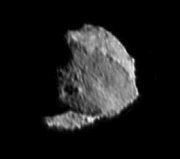
Posted by: Explorer1 Nov 30 2023, 02:53 AM
Thanks for the anaglyph; definitely seems like Bennu/Ryugu had gotten beat up. It's also more obvious that Selam is a contact binary, even from this angle. Much like the Rosetta images of 67P looked from 'above' the smaller lobe, with the bigger one peeking out.
Posted by: stevesliva Nov 30 2023, 04:30 AM
https://en.wikipedia.org/wiki/52246_Donaldjohanson also has a strange lightcurve. 17 months till then.
Posted by: Phil Stooke Nov 30 2023, 07:25 PM
Those animations are really helpful. Thanks.
Phil
Posted by: john_s Jan 25 2024, 07:09 PM
Big burn coming up next week: https://blogs.nasa.gov/lucy/2024/01/25/nasas-lucy-ready-for-2024-mission-milestones/
John
Posted by: Phil Stooke Jan 29 2024, 12:35 AM
Look out for some goodies on our Dinky asteroid at LPSC (abstracts to be released soon) - including something by John.
Phil
Posted by: john_s Feb 2 2024, 10:41 PM
https://blogs.nasa.gov/lucy/2024/02/01/nasas-lucy-completes-first-main-engine-burn/. The second, larger, part of the burn is scheduled for tomorrow.
And Phil may be disappointed by the LPSC abstracts- they are carefully written to avoid releasing substantial new information. We'll have much more to say at the conference itself.
John
Posted by: Phil Stooke Feb 3 2024, 07:15 AM
Hmmm... yes, I see that!
Posted by: stevesliva Feb 5 2024, 02:45 PM
Hopefully the pipeline for reporting the status of that bigger burn is only operable M-F 9-5 because it's early Monday and I'm curious.
Posted by: Explorer1 Feb 5 2024, 04:58 PM
https://blogs.nasa.gov/lucy/
Posted by: Hungry4info Feb 16 2024, 04:58 AM
This paper has some early results, imagery, etc, of the Dinkinesh flyby.
The Discovery of a Contact-Binary Satellite of the Asteroid (152830) Dinkinesh by the Lucy Mission
https://www.researchsquare.com/article/rs-3911173/v1
Posted by: Floyd Feb 16 2024, 02:15 PM
Thanks Hungry4info, that is a nice article. Looks like it will come out in Nature eventually.
Powered by Invision Power Board (http://www.invisionboard.com)
© Invision Power Services (http://www.invisionpower.com)

